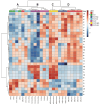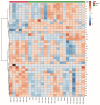Evaluation of Resistance Induction Promoted by Bioactive Compounds of Pseudomonas aeruginosa LV Strain against Asian Soybean Rust
- PMID: 39203418
- PMCID: PMC11355946
- DOI: 10.3390/microorganisms12081576
Evaluation of Resistance Induction Promoted by Bioactive Compounds of Pseudomonas aeruginosa LV Strain against Asian Soybean Rust
Abstract
Pseudomonas are known as higher producers of secondary metabolites with antimicrobial properties and plant growth promoters, including resistance induction. These mechanisms should be an alternative to pesticide use in crop production. Phakopsora pachyrhizi causes Asian soybean rust, representing a high loss of yield around the world. The objective of this paper was to evaluate the application of secondary metabolites produced by Pseudomonas aeruginosa LV strain from the semi-purified fraction F4A in soybean plants to induce plant resistance against P. pachyrhizi in field conditions. The experimental design was performed in randomized blocks with three replicates using two F4A doses (1 and 10 μg mL-1) combined or not with fungicides (Unizeb Gold® or Sphere Max®). The control treatment, with Uni + Sph, saponins, flavonoids, and sphingolipids, showed higher intensities in the plants. In contrast, plants treated with the F4A fraction mainly exhibited fatty acid derivatives and some non-identified compounds with nitrogen. Plants treated with Sphere Max®, with or without F4A10, showed higher intensities of glycosylated flavonoids, such as kaempferol, luteolin, narigenin, and apigenin. Plants treated with F4A showed higher intensities of genistein and fatty acid derivatives. These increases in flavonoid compound biosynthesis and antioxidant properties probably contribute to the protection against reactive oxygen species (ROS).
Keywords: Phakopsora pachyrhizi; antimicrobial; flavonoid; metabolomic; phenazine.
Conflict of interest statement
The authors declare no conflicts of interest.
Figures



References
-
- Conab Acompanhamento da Safra Brasileira de Grãos (Monitoring the Brazilian Grain Harvest) [(accessed on 12 July 2024)];2023 Available online: http://www.conab.gov.br.
-
- Philis G., Gracey E.O., Gansel L.C., Fet A.M., Rebours C. Comparing the primary energy and phosphorus consumption of soybean and seaweed-based aquafeed proteins—A material and substance flow analysis. Clean. Prod. 2018;200:1142–1153. doi: 10.1016/j.jclepro.2018.07.247. - DOI
-
- Hoppe H.H., Koch E. Defense reactions in host and nonhost plants against the soybean rust fungus (Phakopsora pachyrhizi Syd.) J. Phytopathol. 1989;125:77–88. doi: 10.1111/j.1439-0434.1989.tb01058.x. - DOI
-
- Koch E., Ebrahim Nesbat F., Hoppe H. Light and electron microscopic studies on the development of soybean rust (Phakopsora pachyrhizi Syd.) in susceptible soybean leaves. Phytopathol. Z. 1983;106:302–320. doi: 10.1111/jph.1983.106.4.302. - DOI
LinkOut - more resources
Full Text Sources

